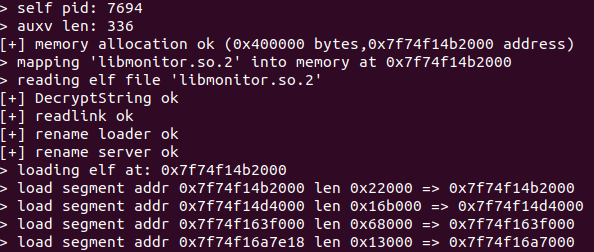Malware
Earth Lusca Employs New Linux Backdoor, Uses Cobalt Strike for Lateral Movement
While monitoring Earth Lusca, we discovered an intriguing, encrypted file on the threat actor's server — a Linux-based malware, which appears to originate from the open-source Windows backdoor Trochilus, which we've dubbed SprySOCKS due to its swift behavior and SOCKS implementation.
In early 2021, we published a research paper discussing the operation of a China-linked threat actor we tracked as Earth Lusca. Since our initial research, the group has remained active and has even extended its operations, targeting countries around the world during the first half of 2023.
While monitoring the group, we managed to obtain an interesting, encrypted file hosted on the threat actor’s delivery server. We were able to find the original loader of the file on VirusTotal and successfully decrypted it. Interestingly, the decrypted payload is a Linux-targeted backdoor that we have never seen before. The main execution routine and its strings show that it originates from the open-source Windows backdoor Trochilus, with several functions being re-implemented for Linux systems. We named this new Linux variant SprySOCKS, referring to the swift behaviors of Trochilus and the new Socket Secure (SOCKS) implementation inside the backdoor.
Analysis of the SprySOCKS backdoor reveals some interesting findings. The backdoor contains a marker that refers to the backdoor’s version number. We have identified two SprySOCKS payloads that contain two different version numbers, indicating that the backdoor is still under development. In addition, we noticed that the implementation of the interactive shell is likely inspired from the Linux variant of the Derusbi malware.
Meanwhile, the structure of SprySOCKS’s command-and-control (C&C) protocol is similar to one used by the RedLeaves backdoor, a remote access trojan (RAT) reported to be infecting Windows machines. It consists of two components, the loader and the encrypted main payload. The loader is responsible for reading, decrypting, and running the main payload.
Similar to the Windows version, the Linux variant analyzed in this report also consists of these two components. Previously, it was reported that RedLeaves was also built upon the publicly available source code of Trochilus.
So far, we have only observed SprySOCKS used by Earth Lusca. In this blog entry, we will provide more context on Earth Lusca’s use of the malware, together with a thorough analysis of its components and capabilities.
Recent Earth Lusca activity
Earth Lusca remained active during the first half of 2023, with its attacks focusing primarily on countries in Southeast Asia, Central Asia, and the Balkans (with a few scattered attacks on Latin American and African countries). The group’s main targets are government departments that are involved in foreign affairs, technology, and telecommunications.
Earth Lusca is now aggressively targeting the public-facing servers of its victims. Furthermore, we have seen them frequently exploiting server-based N-day vulnerabilities, including (but not limited to) the following:
| Vulnerability | Description |
|---|---|
| CVE-2022-40684 | An authentication bypass vulnerability in Fortinet FortiOS, FortiProxy and FortiSwitchManager |
| CVE-2022-39952 | An unauthenticated remote code execution (RCE) vulnerability in Fortinet FortiNAC |
| CVE-2021-22205 | An unauthenticated RCE vulnerability in GitLab CE/EE |
| CVE-2019-18935 | An unauthenticated remote code execution vulnerability in Progress Telerik UI for ASP.NET AJAX |
| CVE-2019-9670 / CVE-2019-9621 | A bundle of two vulnerabilities for unauthenticated RCE in Zimbra Collaboration Suite |
| ProxyShell (CVE-2021-34473, CVE-2021-34523v, CVE-2021-31207) | A set of three chained vulnerabilities that perform unauthenticated RCE in Microsoft Exchange |
Table 1. The list of vulnerabilities exploited by Earth Lusca
Earth Lusca takes advantage of server vulnerabilities to infiltrate its victim’s networks, after which it will deploy a web shell and install Cobalt Strike for lateral movement. The group intends to exfiltrate documents and email account credentials, as well as to further deploy advanced backdoors like ShadowPad and the Linux version of Winnti to conduct long-term espionage activities against its targets.
The “mandibule” loader component
At the beginning of our investigation, we observed a file named libmonitor.so.2 hosted on Earth Lusca’s delivery server. Without previous context, this seemed to be a binary file containing only random bytes, indicating that it is likely an encrypted payload. We used the unique file name to perform a search on VirusTotal that allowed us to identify a related ELF file (SHA256: 65b27e84d9f22b41949e42e8c0b1e4b88c75211cbf94d5fd66edc4ebe21b7359) named “mkmon”. The ELF file could be used to decrypt the libmonitor.so.2 file and recover its original payload, proving that “mkmon” is the loader bundled with libmonitor.so.2.
The loader was not developed from scratch — its developer used a publicly available Linux ELF injector called “mandibule” (the French word for mandible, or lower jaw). The original ELF injector project is a command-line tool with the ability to inject a payload into itself (self-injection) or into another project. As a typical command-line tool, it prints usage text that lists supported parameters. The original injector also prints various debug messages to inform the user about the progress of the injection.
The threat actor used the mandibule project as a basis for its malware loader. The project creator removed the usage screen and the ability to inject to other processes, and then added a function to load and decrypt the second stage. We consider this job to be sloppily done since the developer did not bother to remove debug messages, and the loader was not stripped (that is, it was distributed with debug symbols). Indeed, the threat actor seemed to put minimum effort into modifying the original injector just to be able to make it load the payload.
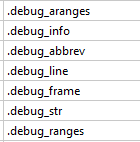
The debug messages displayed in Figure 2 have two distinct markers. The “>” marker is from the original mandibule project, while the “[+]” or “[-]” markers are debug messages added to the loader by the threat actor.
The name of the loader’s process is set to “kworker/0:22” by the prctl command. Normally, kworker is a placeholder process for kernel worker threads. In this scenario, however, the “kworker” name has nothing to do with kernel worker threads. Instead, the loader abuses this name just to avoid suspicion when the user lists all running tasks via commands such as ps or top.

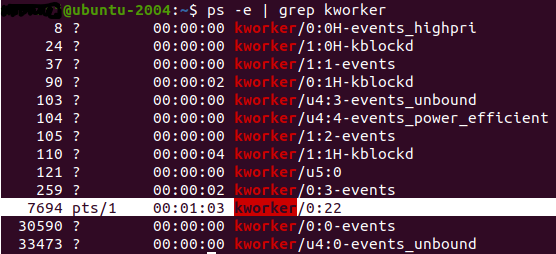
The loader accepts two command-line parameters: the path to the encrypted second stage file and the self-delete flag. The second stage is encrypted with an AES-ECB cipher, with the password being hard-coded in the loader.

The loader is also responsible for setting the persistence. It copies itself and the encrypted second stage to the /usr/sbin/ directory (see debug notes “[+] rename loader ok” and “[+] rename server ok”). It then uses chkconfig or systemd to start the loader as a service. If the self-delete flag is set to “1”, then the originally executed loader and the encrypted stage files are both deleted.
The SprySOCKS component
While examining the decrypted second stage, visible strings revealed that it was statically compiled with HP-Socket project, a high-performance network framework of Chinese origin.

Initialization procedure reveals a hard-coded AES-ECB password used for encrypting communication with the C&C server.

The C&C address and port are also hard-coded in the module, but they are not encrypted and are visible in plain text.

C&C communication consists of packets sent via TCP (Transmission Control Protocol). The packet has a header consisting of 0x12 bytes, followed by a base64-encoded, AES-ECB-encrypted message. Similar to Table B-2 in this previous analysis of the RedLeaves malware, the header contains some random and hard-coded values, plus the length of the payload (highlighted in blue in Figure 9).


The fixed value used in the original Trochilus is 0xAFAFBFBF, while in the RedLeaves variant it is 0xBFD9CBAE.
After decoding and decrypting the message, it reveals keywords such as “__handler”, “__msgid”, “__serial”, and “clientid”. Some of these keywords can be found in Trochilus, but more importantly, these messages closely resemble the RedLeaves communication protocol.

The RAT implements several standard backdoor commands, including the collecting system information, starting an interactive shell, listing network connections, creating SOCKS proxy, uploading and downloading files, and other basic file operations (listing, deleting, renaming, and creating a directory). Table 2 shows message IDs and the approximate descriptions of what functions the messages are related to.
| Message ID | Notes |
|---|---|
| 0x09 | Gets machine information |
| 0x0a | Starts interactive shell |
| 0x0b | Writes data to interactive shell |
| 0x0d | Stops interactive shell |
| 0x0e | Lists network connections (parameters: “ip”, “port”, “commName”, “connectType”) |
| 0x0f | Sends packet (parameter: “target”) |
| 0x14, 0x19 | Sends initialization packet |
| 0x16 | Generates and sets clientid |
| 0x17 | Lists network connections (parameters: “tcp_port”, “udp_port”, “http_port”, “listen_type”, “listen_port”) |
| 0x23 | Creates SOCKS proxy |
| 0x24 | Terminates SOCKS proxy |
| 0x25 | Forwards SOCKS proxy data |
| 0x2a | Uploads file (parameters: “transfer_id”, “size”) |
| 0x2b | Gets file transfer ID |
| 0x2c | Downloads file (parameters: “state”, “transferId”, “packageId”, “packageCount”, “file_size”) |
| 0x2d | Gets transfer status (parameters: “state”, “transferId”, “result”, “packageId”) |
| 0x3c | Enumerates files in root / |
| 0x3d | Enumerates files in directory |
| 0x3e | Deletes file |
| 0x3f | Creates directory |
| 0x40 | Renames file |
| 0x41 | No operation |
| 0x42 | Is related to operations 0x3c – 0x40 (srcPath, destPath) |
Table 2. List of handled messages and an explanation of their functions
The client information structure resembles the original CLIENT_INFO structure used by Trochilus, with some parameters being the same for both Trochilus and the malware we were analyzing. It is also worth noting the parameter “cpufrep”, which is likely a typo of “cpufreq” (CPU frequency).
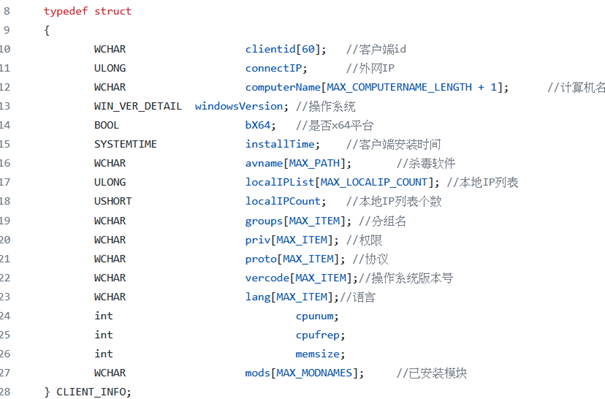
Further down in ClientInfoManager.cpp, the Trochilus RAT, you can see the internal names of the parameters from the CLIENT_INFO structure. Note that most of them have the same values as the listed parameters in Table 2. Furthermore, “cn”, “ip”, “groups”, “vercode”, “priv”, “lang”, “mem”, “os”, “x64”, and “cpufrep” are the same.
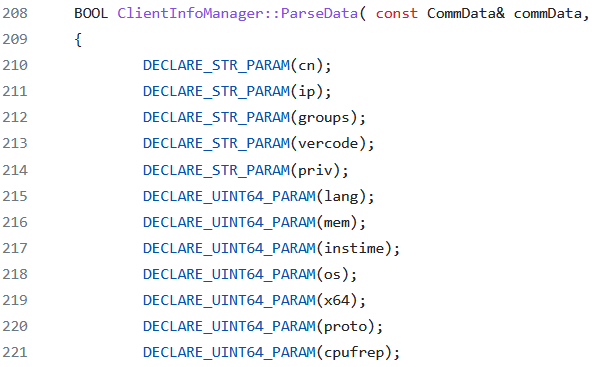
| Parameter | Command | Notes |
|---|---|---|
| cn | gethostname | Computer name |
| systemType | uname; cat /etc/issue; cat /etc/redhat-release | |
| systemVersion | uname; cat /etc/issue; cat /etc/redhat-release | |
| os | uname; cat /etc/issue; cat /etc/redhat-release | |
| mem | sysinfo; totalram | Total RAM in MiB |
| vercode | uname; cat /etc/issue; cat /etc/redhat-release | OS version number |
| x64 | uname; cat /etc/issue; cat /etc/redhat-release | Determines whether the OS is 64-bit |
| ip | getifaddrs | IP addresses except for localhost |
| groups | getuid | Group name |
| priv | getpwuid; pw_name | Privilege/Username |
| lang | echo $LANG | Language |
| languageStr | Language | |
| cpunum | get_nprocs_conf | Number of processors |
| cpufrep (sic!) | cat /proc/cpuinfo|grep cpu\\ MHz|sed -e ‘s/.*:[^0-9]//’ | CPU frequency |
| mods | No value | Installed modules according to the comment on the Trochilus source code |
| save_screen_dir | Constant value | 1 |
| reportTime | time | Current time |
| versionType | Constant value, refer as backdoor type “Linux” | LIN |
| versionNumber | Constant value, refer as backdoor version | 1.3.6 |
Table 3. List of fields in the CLIENT_INFO structure of SprySOCKS
When a client is requested to create an interactive terminal, it first interacts with the master endpoint for the pseudo-terminal (PTY) subsystem (/dev/ptmx). Afterward, a new slave PTY is created with a unique device node name in the /dev/pts directory.
After this, an execve command is launched with the parameter “[diskio]”, environment variables instructing it not to save session history (HISTFILE=/dev/null), and prompt string (PS1) containing current username (u), host name of machine (h), and working directory, which is (w) - (PS1=\\u@\\h:\\w \\$).

When searching for the aforementioned strings, it’s possible to find a reference to YARA rules matching the Linux version of Derusbi. It is likely that the threat actor gained inspiration from the techniques used by other pieces of malware or possibly even had direct access to the Derusbi source code itself.
The environment ID (client ID) consists of two components. The first part is the MAC address of the first listed interface (the malware gets the first listed interface, but if this interface is "loopback interface", then this interface is skipped and the next interface is considered) with a length of 6 bytes; this, when converted to a hexadecimal string, has a length 12 bytes. The second part corresponds to processor features, returned by the CPUID instruction called with the “CPUID_GETFEATURES” parameter. The length of the result is 8 bytes; when converted to a hexadecimal string, this has a length of 16 bytes. Thus, the generated client ID has 14 bytes, and after its conversion to a hexadecimal string, it has 28 bytes.
Attribution
We observed the encrypted SprySOCKS payload hosted on the delivery server 207[.]148[.]75[.]122 in early June 2023. The server, which was operated by the Earth Lusca threat actor, also delivered executable files of Cobalt Strike and the Linux version of Winnti to its targets.
The SprySOCKS payload contains a version number (1.3.6) and the C&C domain lt76ux[.]confenos[.]shop. We found another SprySOCKS payload uploaded by other users on VirusTotal with a version number of 1.1 and which connected to the C&C domain 2e6veme8xs[.]bmssystemg188[.]us. It’s worth noting that the sibling domain rvxzn49eghqj[.]bmssystemg188[.]us resolved to 38[.]60[.]199[.]208, which overlapped with 793tggz7mw91[.]itcom666[.]live. The domain itcom666[.]live is a known C&C domain attributed to Earth Lusca.
Conclusion
In this report, we discussed the new backdoor SprySOCKS used by Earth Lusca, which expands the group’s Linux arsenal. Recently, the threat actor has been highly aggressive in targeting the public-facing servers of its victims by exploiting known vulnerabilities.
It is important that organizations proactively manage their attack surface, minimizing the potential entry points into their system and reducing the likelihood of a successful breach. Businesses should regularly apply patches and update their tools, software, and systems to ensure their security, functionality, and overall performance.
Cutting-edge and adaptable security solutions like Trend Micro XDR play a pivotal role in safeguarding organizations against Earth Lusca and other threat actors. These technologies excel at gathering and connecting activity data across various channels, from emails and endpoints to servers, cloud workloads, and networks. This comprehensive approach empowers organizations with a high level of security detection and investigation capabilities, setting it apart from conventional security solutions.
Indicators of Compromise (IOCs)
The indicators of compromise for this entry can be found here.


